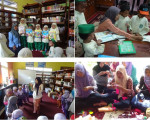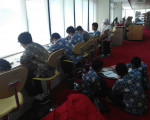Collaboration Between Libraries
Writer:
Hendrikus Franz Josef, M.Si
Regional Library and Archive Office of
2019
Abstract
Implementation of three tertiary service programs, namely education, teaching,
research, and community service require library support. Libraries in universities function as information sources/documentation centers, research supporters, and learning resource centers. The role of the library as a source of information is to provide information to library users, either at the user's request or even without being asked. Libraries are often used as a place to obtain information relating to the daily tasks of users and other general information. With its collection, the library must try to answer every question posed by library users. The role of the library as a documentation center is to store human works such as books in a broad sense, including printed or graphic forms, non-print, electronic forms, and others. For example, college libraries usually function as deposit libraries whose duty is to store all public institutions, such as research documents, research reports, theses, theses, and dissertations. The role of the library for research activities is to provide information for support research. In supporting research programs, libraries
assigned to provide a list of books, a list of journal articles, make/compile abstracts
scientific writing and so on. In addition, the library also provides a list of selected articles according to the subject or topic of the research being worked on by a lecturer and researcher. The role of the library as a center for learning resources is as a place of education lifetime. Someone who has left college can continue to do so
the learning process in the library. In the library someone can develop knowledge, insights and other abilities to support the profession and his work.
Part I
Background of Library Collaboration
Essentially there may be no single library, however big the library is, that is able to acquire all of the statistics produced by means of publishers and writers throughout the arena, even for the maximum precise clinical disciplines. Understanding this, every library or facts center always attempts to establish cooperation with existing libraries or data centers. The definition of collaboration between libraries is collaboration that involves two or extra libraries. There are several elements that inspire collaboration between libraries, namely:
1. There may be a amazing boom in science and have an effect on more and
morebooks are written approximately that know-how;
2. Vast academic activities, ranging from fundamental schools to tertiary
establishments, encourage more and more numerous user requests that
increasingly require facts from daily;
3. Development inside the area of generation with its various impacts on
industry and alternate and the need for leaders and personnel to increase
new competencies and techniques. These talents, amongst others, may be
received from reading;
4. Development of possibilities and possibilities for worldwide cooperation and
international site visitors; both of these encourage the state-of-the-art
records about overseas nations;
5. The development of records technology, particularly within the field of
computer systems and telecommunications, permitting the implementation
of cooperation to run faster and simpler, even cheaper;
6. The needs of the network to achieve the equal data services. All this time is
a reality that the network of facts customers in large towns attain facts
offerings higher than users who stay in the area remoted;
7. Collaboration permits saving of centers, charges, human resources and
time. An activity or business done through several human beings (establishments, authorities, and so forth.) to attain common dreams inside the equal fields. Furthermore, sulistyo basuki (1996) states that there are terms which are intently related to the time period library collaboration, specifically information networks. Each have extraordinary historic components. Collaborative libraries contain collaboration amongor more libraries without seeing whether or not the collaboration makes use of the assist of computers or telecommunications centers or no longer. Whilst statistics networks similarly to enforcing cooperation the usage of information generation devices, the participants are not best constrained to libraries however also other data gadgets, inclusive of the documentation middle, information center, facts analysis middle, reference middle, records financial institution and housework. The principle of collaboration between libraries is carried out because it is assumed that no library has a whole series, so cooperation with other libraries is wanted. So, what is supposed via library cooperation is an pastime or effort performed by means of several libraries to attain the purpose of the library in offering and utilizing its series for the gain of users, readers in various hobbies. Suprihati, (2004) argues that library collaboration hasmain things, particularly realizing the vision and task of the library, and each of them acquire brought value or benefit from the collaboration of the library.
Part II
Various Types of Library Collaboration
Library collaboration system, documentation and data is an incorporated arrangement of organizations occupied with data preparing, for example, libraries, documentation focuses, data examination focuses, data focuses with the point of giving significant information section regardless of the structure and root of client information needs. The regular types of library collaboration include:
1. Participation in securing library assortments.
This cooperation is completed by a few libraries cooperating in obtainment of books. Every library is answerable for the wearer's data needs by choosing books on demand the wearer or dependent on supposed curator information on need the wearer. The books for client needs were secured together by the library designated as the organizer of the joint effort. Assortment arrangement did in every library that arranged the book, anyway these books can be utilized mutually by every client library.
2. Community Trade and Redistribution of Library Assortments.
Trade participation is done by trading distributions of the parent office the library with different libraries without purchasing. This strategy is typical likewise to get distributions that are not sold or productions that are difficult to follow in book shops. This trade is generally done by rule coordinated implies that one production is traded with one distribution with no taking a gander at the quantity of pages, the thickness of the distribution or the cost of the distribution. Redistribution participation is a joint effort did by two libraries or more as far as the re-position of books that are never again required at one library or abundance in a library. The book can offered to different libraries that may require that books.
3. Collaboration in Handling Library Materials.
In this type of coordinated effort, the library works together to process materials library. For the most part at college libraries with different branches or open library with its branches, handling library materials, for example, classifying, arrangement, marking of books, book cards and others. this should be possible by a library that is the organizer of participation.
4. Participation in Giving Offices.
This type of cooperation may feel bizarre for libraries in created nations on the grounds that their libraries are commonly constantly open for use by clients general. In this structure, libraries concur that their assortments are open for other library clients. Libraries typically give offices as chances to utilize assortments, utilizing library administrations, for example, search, streak data, utilization of a copier, yet not open chance to get. Typically getting books for borrowers isn't individuals are completed utilizing between library advance offices.
5. Cooperation between library
This type of cooperation is done in light of the fact that other library clients can't get another library assortment. Rather the library is loan books from different libraries then the library loan it to the wearer. Who is liable for obtaining the book is a library that acquires.
6. Participation Between Librarians.
This joint effort was completed between custodians to comprehend a few issues looked by curators. This type of coordinated effort appears as
distributing manuals for curators, gatherings between custodians, courses
refreshment for curators and others.
7. Participation in Incorporating the Ace List.
Two libraries or more assemble a library list together. The list contains data about books possessed by the library members of the cooperation were joined by data about the area of the book. Participation like this isn't new in
8. Collaboration in Giving Administrations and Data.
This type of coordinated effort is completed by at least two libraries that concur to help out one another to give data administrations. One type of this joint effort is acquiring between libraries, search benefits, and photocopying administrations. Collaboration like this includes every one of the assets in the library. So it isn't constrained to loaning between libraries
Conclusion
The concept of library cooperation uses the principle of synergy, because basically the library will not be able to meet the needs of users of the library materials needed. There are several reasons why libraries need cooperation, among others, because more books are published each year so that libraries cannot afford new books for user needs. Also various types of media published, the reasons for the user's need for various information, as well as readings. This is caused by people receiving the same information / documents that are approved by looking at where they are and because of technological developments, especially computer and telecommunications technology.
The development of many information technologies improves the information process both locally, regionally and internationally. Actually what offers access information is information both print and non-print and from various sources of information quickly and accurately, especially by using computer technology. The computer used to access information must have a connection on a computer network. A computer network is a collection of computers connected to each other using communication protocols through transmission media or communication media. This computer network supports to carry data-information from the sender to the recipient (access to information) quickly and accurately without going through a transmission medium or certain communication media. Collaborative libraries should be a concern with SliMS users, more so for complete libraries, for example libraries in one district.
This collaboration has many benefits: 1. Library workbooks can overcome problems in terms of funds for the procurement of library materials, especially for the procurement of supporting collections. 2. The image of the library can be lifted because "impressed" there is always new library material in the library, 3. Helping librarians in terms of management, especially if managing a limited library, not only limited to the number of libraries. human resources are also limited in terms of classification and cataloging capabilities. 4. Between library managers can share knowledge about new things they get. Thus, this actually can overcome the limitations of HR development costs as well. For library cooperation, a meeting needs to be held to hold a relationship. Therefore, in this forum we invite library managers to ask for library assistance more seriously by using this SliMS application.
Bibliography
Brandt, D. Scott. "Librarians as partners in e-research: Purdue University Libraries promote collaboration." College & Research Libraries News 68.6 (2007): 365-396.
Duff, Wendy M., et al. "From Coexistence to Convergence: Studying Partnerships and Collaboration among Libraries, Archives and Museums." Information Research: An International Electronic Journal 18.3 (2013);
Farkas, Meredith G. Social software in libraries: building collaboration, communication, and community online. Information Today, Inc., 2007.
Hardjoprakoso, Mastini. 1992. Sistem Jaringan Informasi bagi Kegiatan Nasional
maupun Internasional. dalam Kepustakawanan Indonesia: Potensi dan
Tantangan, Jakarta: Kesaint Blanc.
Huda, Nuril. 1994. Manajemen Pelayanan Pengguna.dalam Lokakarya Manajemen
Perpustakaan Perguruan Tinggi Negeri se-Indonesia. Jakarta: Proyek PS2PT
Ditjen Dikti.
Sulistyo-Basuki. 1991. Pengantar Ilmu Perpustakaan. Jakarta: Gramedia Pustaka
Utama
Perpustakaan Lainnya
 KUNJUNGAN TK ABA WOJO DAN PAUD TERPADU MUTIARA HATI KE RUMAH BELAJAR MODERN
KUNJUNGAN TK ABA WOJO DAN PAUD TERPADU MUTIARA HATI KE RUMAH BELAJAR MODERN
Perpustakaanyang memiliki berbagai kegiatan ini sering menerima kunjungan darisekolah-sekolah, karena diperpustakaan ini memiliki...
 Kunjungan Rombongan ke Grhatama Pustaka Membludak
Kunjungan Rombongan ke Grhatama Pustaka Membludak
Masyarakat dari berbagai daerah sangat antusias mengunjungi Grhatama Pustaka, hal ini dapat dilihat dari data statistik kunjungan...
 Management and Process Preservation of Library Materials
Management and Process Preservation of Library Materials
Management and Process Preservation of Library Materials Writer: Hendrikus Franz Josef, M.Si Regional...
 KUNJUNGAN TK ABA KETANGGUNGAN YOGYAKARTA DI GRHATAMA PUSTAKA
KUNJUNGAN TK ABA KETANGGUNGAN YOGYAKARTA DI GRHATAMA PUSTAKA
Minggu pagi, 20 Februari 2016Grhatama Pustaka mendapat kunjungan dari TK ABA KETANGGUNGAN YOGYAKARTA yangdisambut oleh Ibu Wiwik...

 Kegiatan Penyususnan Katalog Induk Daerah (KID)
Kegiatan Penyususnan Katalog Induk Daerah (KID)